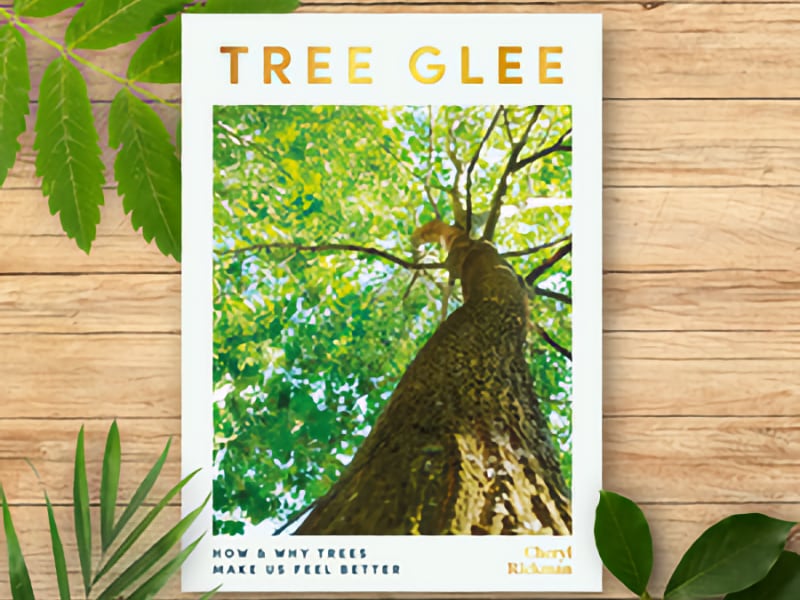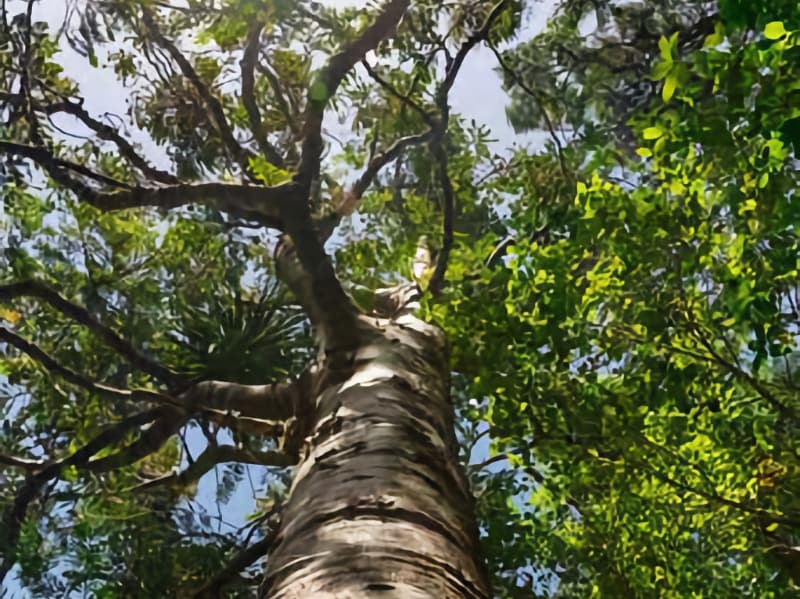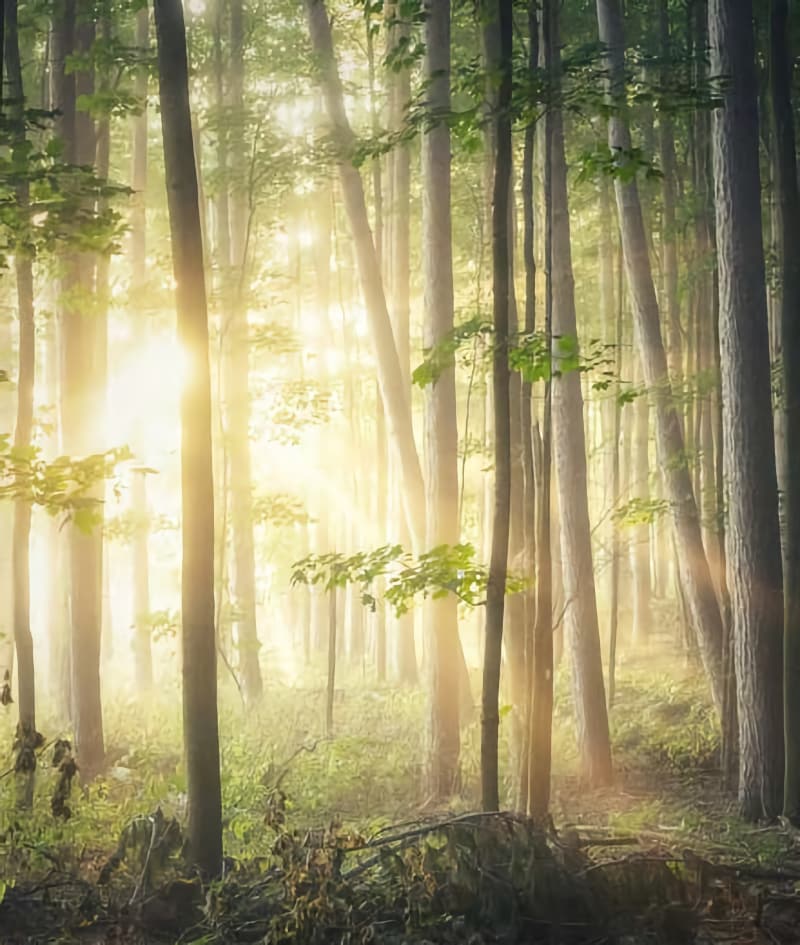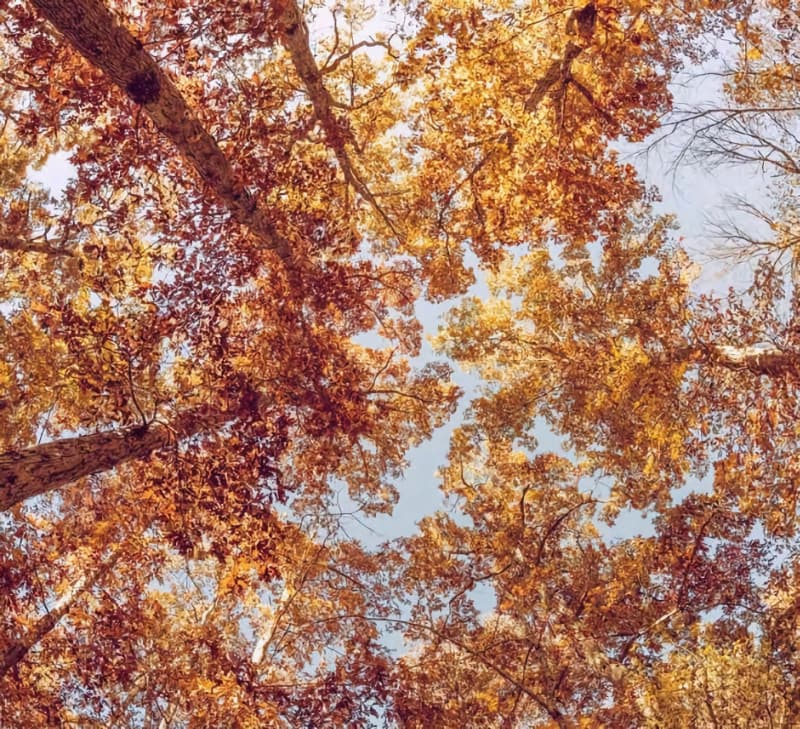
By Cheryl Rickman
www.TreeGlee.co.uk
Includes extracts from TREE GLEE: How and why trees make us feel better (£16.99, Welbeck Balance)
Across the duration of our life, from cradle to grave, trees support us – from the pine and poplar of the cots we sleep in as babies to the Oak coffins that surround us on our final journey. Meanwhile, trees have given us the timber, tools and scaffold with which to build our homes, the ships with which to explore the world and generously provided shade from the heat of the sun when we arrived on land.
Wood has given us fuel to warm ourselves and to smelt with, silk to dress ourselves in, arrows to hunt with and musical instruments and stages on which to perform and entertain each other. We’ve gleaned aspirin, cancer drugs and anti-inflammatories from tree bark and pine needles and trees are on planet-saving duty too. Trees remove pollutants, limit flooding and sequester carbon for us.

Yet, it’s easy for us to take the trees all around us for granted. Consequently, there are now half the number of trees on Earth than there were 12,000 years ago, and each year we destroy as much forest as would cover the whole of Belgium.
Scientists have even named this apathy “plant blindness”. Too many love trees too little. Perhaps it’s because trees make us feel good without us realizing. We simply breathe the air they clean for us and walk on the unflooded earth; we don’t hear the noise pollution they’ve muffled and don’t choke on the air pollution they’ve absorbed. We can’t see the carbon they’ve locked away, so we don’t always notice these living wonders who make our lives better and easier.
This plant blindness is a great shame – not just because our care and protection of trees is vitally important for the health of our planet, but because by deepening our appreciation and connection with trees, we can boost both our own physical and mental health significantly too. You see, trees can help us to feel better in a myriad of ways, as I wrote about previously here.

Trees make our bodies and minds feel better by producing a glorious cocktail of botanical compounds, which work to soothe our autonomic nervous system and boost our sleeping ability, which makes us feel calmer. These compounds are a blend of essential oils called phytoncides and aromatic terpenes, which trees diffuse between each other to attract pollinators and protect themselves from bacteria, insects and fungi. Spending time around trees has also been shown to impact heart health and boost immunity, among many other physical health benefits.
And during a time of rising anxiety and depression – surely it’s more important than ever before to tap into the power of trees to calm our nervous system, boost our immune system and lift our spirits? Especially given how stress has been deemed the health epidemic of the 21st century by the World Health Organization. And, while time spent outdoors is on the decrease, anxiety, depression and other mental health illnesses are on the increase; a link we can surely no longer ignore.
The problem is, despite being wired to connect with nature and to feel at home when we’re immersed in it, we have become intrinsically indoor people. Indeed, in the year 2000, human beings officially became an urban species, with almost 4 billion people living in cities, and that number projected by the UN to rise to 75 per cent of the global population by 2050.
We currently spend between 90 and 93 per cent of our time indoors (and 6 per cent of that time inside cars), and we spend more time on screens than we spend sleeping, glued to our devices for between eight and eleven hours each day, according to UK communications regulator Ofcom.
Evidently, this divorce from nature comes at a pivotal time – we have never needed to reconnect with nature more than we do today. By staying in we’re missing out. In our head-down world, it has become more critical than ever before to look up, pay attention to the natural world and allow ourselves to be nurtured by nature.

So, what can we do to move from plant-blindness to plant-awareness? How can we deepen our connection and give back to these arboreal marvels?
In my book, TREE GLEE: How and why trees make us feel better, I delve deeper into the role our ancestral memory plays in the nourishing comfort of trees. But, to fully experience the calming effect, we need to get out there into the woods and parks more often. Here are a few ways to do just that:
CONNECT
- Commit to going on a daily woodland walk, or one long walk each weekend. A University of Exeter study of 20,000 people found those who spent two hours per week (20 minutes per day) in green spaces, woods/parks or other natural environments, whether at once or cumulatively, were more likely to report good psychological and physical health than those who didn’t.
- Use a plant identification app to find out about a tree in your garden or neighbourhood, then dig deeper. Research your tree to find out what its wood has traditionally been used for in terms of tools, food, medicines, or other resources to cultivate a deeper sense of gratitude and connection. Find out whether your species of tree is under threat or is widespread? Is it native, invasive? Is there any interesting mythology linked to this type of tree?
- Practice mindful tree photography. Rather than snapping away in haste, searching for the perfect shot, make this into a mindful activity; anchor yourself with a few slow deep breaths, slow down to engage in the present moment, and focus your attention on what draws your curiosity. You will become consciously aware of the tiny details – perhaps the greenery, the leaves, the shape of the branches, the gnarly trunk.
RECIPROCATE
- Start or join a community tree-planting initiative. Studies show that local people working together contributes to the success of tree-planting projects.
- Join a local rewilding or woodland regeneration project. Encouraging trees to self-seed and spread naturally avoids the need for planting yet creates new woodland by balancing the clearing of competitive vegetation with leaving hawthorn and blackberry scrub that protects seedlings from animals and direct seeding activities.
- Become a tree warden to protect local trees or join a deforestation watch group to monitor local lumber companies.
- Research and record your local tree heritage, add to ancient tree inventories and map old woods and trees to help protect them.
- Change your consumption habits. Approximately 27 million hectares of land have been deforested to produce palm oil, which is often found in chocolate, ice cream, baked goods, bread, noodles soap, detergent, shampoo and make-up. Read food labels to avoid buying products containing palm oil.
Globally, forests and city trees are thought to capture almost a quarter of the total global carbon emissions (hundreds of gigatons), including a third of fossil-fuel emissions, partially righting our wrongs. As such, trees have the potential to save the planet. But we knew that already. Now that we know that trees can also save us from our man-made maladies and help calm us down and boost our immunity, perhaps we’ll do more to take care of them and, in the process, take better care of ourselves.
Cheryl Rickman is author of TREE GLEE: How and why trees make us feel better (£16.99, Welbeck Balance) www.TreeGlee.co.uk


